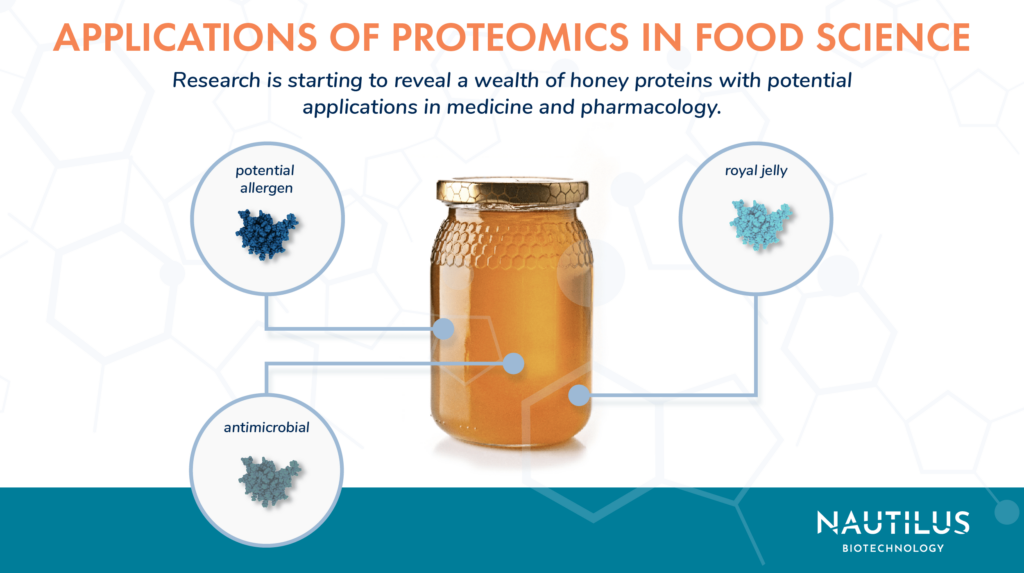
When most people think “protein,” they’re thinking of the macronutrient, one of our three major calorie sources in food. Yet, the many different proteins in food – the complex molecules that do most of the work in cells – form everything from structural components, to flavor compounds, to enzymes that help fruits ripen on the kitchen counter. Proteins contribute to texture, nutrition, shelf life, and can even cause illness.
For decades, it wasn’t always easy to tell proteins apart and know which ones were helpful, which were harmful, and which ones just tasted good. Today, scientists can analyze food samples with proteomics and better understand the full range of proteins they contain. The goal is to learn more about we eat in order to make our foods safer, tastier, more nutritious, and more plentiful.
Examples of current proteomics applications in food science
High-throughput proteomics techniques are particularly useful for “discovery proteomics” or surveying a sample to see what proteins it contains. Later researchers can use “functional proteomics” to find out what those proteins do. These breakthroughs are leading to improvements in our food supply every day, from identifying potential allergens to detecting impurities, to discovering which molecules are responsible for a particular taste in an ingredient. As next-generation proteomics technologies develop, things should only get better. Here are a few examples of current proteomics applications in food science.
Identifying allergenic proteins in shellfish
Shellfish are a delicacy for some people, but for others, can cause allergic reactions that pose serious health risks. It’s been especially hard for scientists to identify shellfish allergens in part because there are so many kinds of shellfish and many potential allergens with a variety of structures. Proteomics and bioinformatics provide researchers with new tools to identify shellfish allergens.
For instance, in a study published in the Journal of Allergy and Clinical Immunology, food scientists tackled this problem using proteomics to discover potential allergenic proteins in the Pacific Oyster, one of the most commonly eaten species. The team used a combination of bioinformatics and discovery proteomics to look at the 25,982 known oyster proteins and then weed out those proteins that might be allergenic.
They first computationally matched oyster proteins against a database of known allergens. Then, they exposed oyster protein extracts to antibodies from allergic human patients and used mass spectrometry to identify the reactive proteins. Cross-referencing the computational and proteomic results led to the identification of 24 previously unreported potential allergenic proteins. These results could help predict potential allergic reactions ahead of time and lead to better symptom management and treatments for people suffering from life-threatening shellfish allergies.
Finding potential medicinal proteins in honey
Honey is an ancient food that’s been used by cultures around the world for thousands of years. Although it appears to be a simple, sweet syrup, honey is in fact a complex mixture of sugars, proteins, and other compounds. Proteins make up less than 1 percent of the material in honey, but recent research is starting to reveal a wealth of honey proteins with potential applications in medicine and pharmacology, and which could even provide a way to verify a honey’s source.
In a paper in the Journal of Natural Products, researchers identified and quantified proteins in 13 different honeys using mass spectrometry. They discovered a number of novel proteins, including antimicrobials, allergens, venom-like proteins, and proteins related to the royal jelly that bees feed their young. They also found an antimicrobial protein, hymenoptaecin, that could lead to a better understanding of honey’s remarkable antimicrobial properties. In addition, because honeybee venom is a known allergen, the detection of honeybee venom proteins in honey could help scientists understand some of the underlying sources of allergic reactions to honey in humans.
Besides identifying and quantifying previously unknown proteins, the scientists found that some of the honeys had as many as 10 times the amount of proteins in their proteome as other honeys, and that eucalyptus honey was significantly different in composition from the other 12 honeys they studied. In addition, proteomic analyses could help create protein fingerprints for specific kinds of honey, allowing for the detection of adulterated honeys. Proteomics clearly has an important role to play in identifying foods with medicinal, pharmacological, and human health applications.
Next-generation proteomics for food science
Proteins are one of the core components of foods, with each person consuming many different kinds of proteins each day. Proteomics will continue to be a critical tool for food science as we gain a better understanding of what proteins are found in food and how they affect us.
Next-generation proteomics technologies such as the NautilusTM Proteome Analysis Platform are designed to provide the single-molecule sensitivity, high dynamic range, and rapid throughput necessary to truly understand the food we eat. As the proteomics revolution gains steam, food science will hopefully be better-positioned than ever before to give us the safest, tastiest, and healthiest food yet.
Check out the Translating Proteomics podcast for an exciting discussion about the applications of proteomics
MORE ARTICLES


